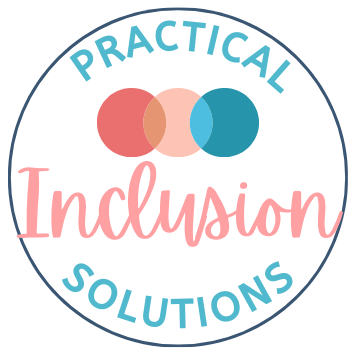Back to School Season: Feeling Overwhelmed?
Getting ready for the new school year and feeling overwhelmed? Want to make your classroom as accessible as possible for all your students? Let’s dive into some easy organizational tips while your brain is still fresh! Here are 10 ways to organize your inclusive classroom before school starts.
An inclusive classroom thrives on thoughtful and meaningful organization. It might seem like a well-organized classroom just flows naturally, but believe me, a lot of thought and effort goes into making it look effortless!
How Do We Organize Our Classroom?
Here are 10 quick tips to help you organize your inclusive classroom for maximum efficiency and accessibility. And don’t forget to grab our freebie—Classroom Organization Notebook—to plan it all out!
1. Create Zones for Different Activities
What to do: Designate specific areas in the classroom for various activities like reading, group work, and quiet time.
How to do it: Use visual markers, rugs, or furniture to clearly define these zones. This helps students know where to go for different types of tasks and supports diverse learning needs.
2. Label Everything Clearly
What to do: Label shelves, bins, and storage areas with both text and pictures.
How to do it: Use clear, large labels to help students with visual processing issues or those who need additional support in finding and organizing materials independently.
3. Set Up a Flexible Seating Arrangement
What to do: Arrange a variety of seating options like desks, chairs, bean bags, and floor cushions.
How to do it: Create a layout that allows students to choose or move between different seating options based on their preferences and needs. Ensure pathways are clear and accessible.
4. Make an Inclusive Materials Station
What to do: Organize a central area with materials and tools that support various learning needs.
How to do it: Include items like assistive technology, sensory tools, adaptive equipment, and diverse learning resources. Ensure these are easily accessible and well-organized.
5. Create a Visual Schedule and Routine Chart
What to do: Develop a visual schedule that outlines the daily routine and classroom rules.
How to do it: Use pictures, symbols, or a visual calendar to help all students understand and follow the classroom routine. This is particularly helpful for students with autism or those who benefit from structured environments.
6. Set Up a Communication Corner
What to do: Designate an area for communication aids and support.
How to do it: Include tools like AAC devices, communication boards, or language support materials. Ensure this area is accessible to students who need alternative or augmentative communication methods.
7. Organize Student Supplies Efficently
What to do: Arrange student supplies in an orderly and accessible manner.
How to do it: Use labeled bins or individual supply kits for each student to keep personal materials organized. Consider having a central supply station for shared items.
8. Establish a Quiet Space
What to do: Create a designated area where students can go for a break or to calm down.
How to do it: Furnish this space with calming tools, soft seating, and sensory items. Make sure it’s easily accessible and clearly marked.
9. Prepare Individualized Learning Stations
What to do: Set up stations with materials tailored to different learning needs.
How to do it: Include stations for individualized instruction or adaptive learning tools. Rotate materials based on student needs and preferences.
10. Plan for Easy Transitions
What to do: Organize materials and routines to facilitate smooth transitions between activities.
How to do it: Use timers, visual cues, and clear instructions to help students understand when and how transitions will occur. This reduces anxiety and helps students adjust more easily.
Implementing these strategies will help create a welcoming, organized learning environment that supports all students. Don’t forget to download our Classroom Organization Notebook to get started!
Want even more information on an inclusive classroom? Check out our free workbook – A Guide to the Inclusive Classroom.
Interested in learning more? Check out these articles as well!
⭐️ Designing and Arranging an Inclusive Classroom
⭐️ A Guide to Creating Inclusive Classrooms
Do you use any of these strategies to organize your inclusive classroom? Share your thoughts in the comments or connect with us on Instagram @practicalinclusionsolutions!
